Greece and the Black Sea
September 9 through September 30, 2013
Our cruise on Oceania Cruise Line's MS Nautica sailed from the Athens port of Pireaus, so we took this opportunity to get our first taste of Greece.| We stayed at the Athens Gate Hotel, which was an easy walk to the Athens Acropolis, which was readily viewed from the hotel's rooftop dining room. With our long layover in London, we arrived after dark. | 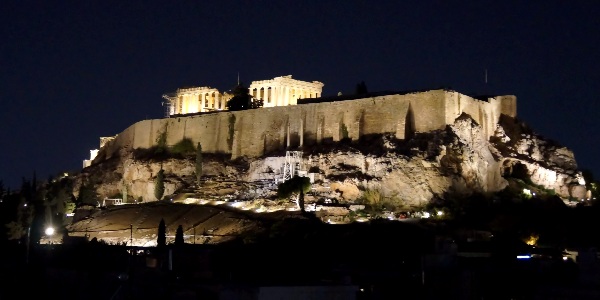 |
| Looking from the front of the Athens Gate Hotel, we saw the Temple of Olympian Zeus. This was started in the 6th C BC, and finished 638 years later by the Roman Hadrian. | 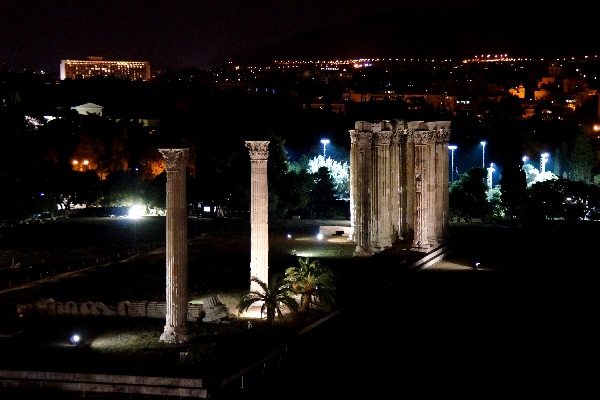 |
| The Temple of Olympian Zeus looks pretty good in the day time, too. After Hadrian's good work, this was the largest temple in Greece. In the 3rd century, the barbarians invaded Athens, and this temple was sorely damaged, and for centuries it was effectively an above-ground marble quarry. | 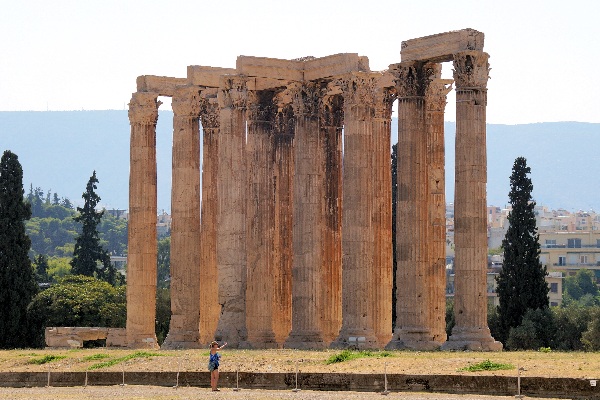 |
| The Plaka was also an easy walk. This might be Sellei Street, but it is typical. Restaurants and street-facing shops. | 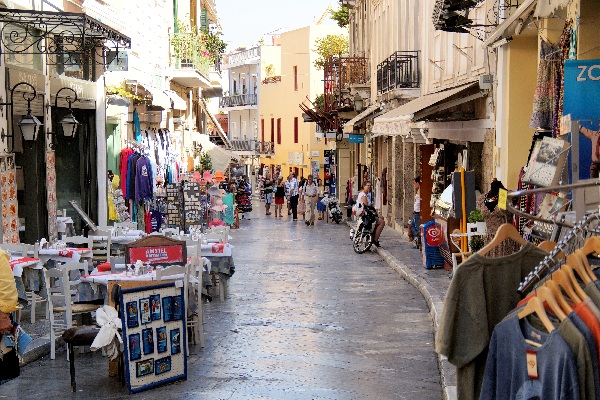 |
| Still in the Plaka, this is an ambulance built for narrow streets. Too bad about the graffiti. | 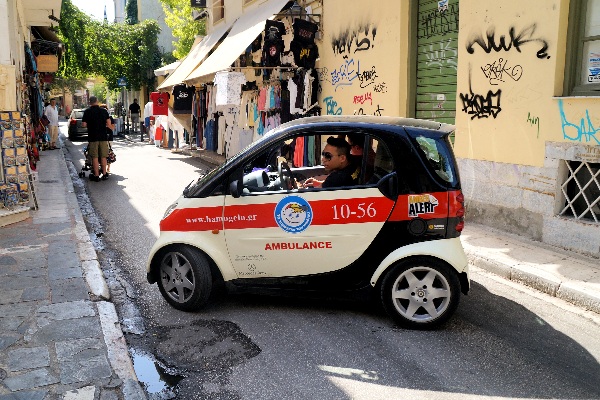 |
| Up until 1834, this was the home of a prosperous Athens businessman, but King Otto decided it should be his seat of government in 1834. When public pressure forced Otto to create a constitution, this was the site of the National Assembly. Of course, there were renovations and expansions along the line. From 1875 until 1934, this was the home of the Greek parliament. | 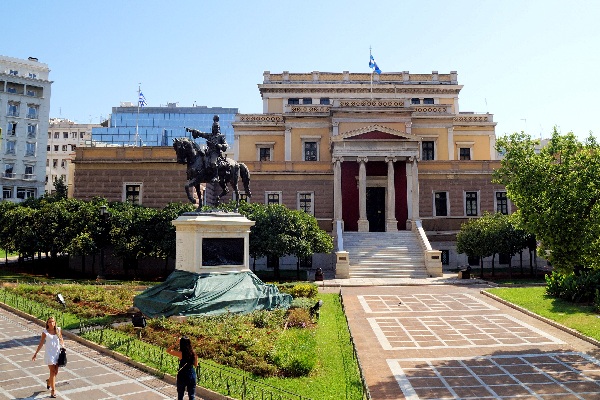 |
| Syntagma Square is the nominal center of Athens, and it is the "front yard" of the Greek Parliament Building. Fortunately, we had no big demonstrations during our visit. This building dates to 1843, but it was a palace for Greek monarchs, starting with Otto, until 1924, when a referendum eliminated the monarchy. It has been the home of the Hellenic Parliament since 1934. Immediately in front of the building is Greece's Tomb of the Unknown Soldier, guarded by Evzones, members of the presidential guard, in their quirky uniforms. |  |
| A Danish architect, Theophil Hansen, designed this building in 1859 to re-establish the Academy of Athens, that being the name of the school run by Plato from about 387 BC. The early version of the modern Academy of Athens occupied this neo-classical building in 1887, and it was more formally chartered in 1926. Clearly a very modern school. | 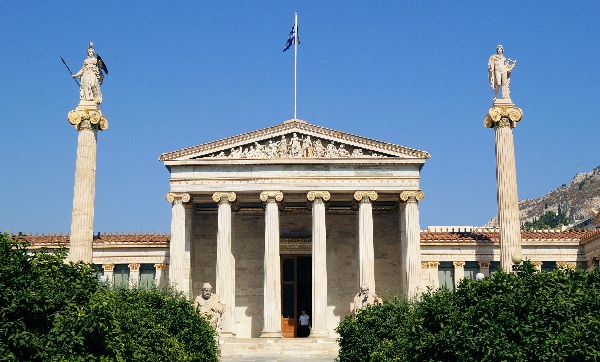 |
| As we traveled around, we found that every ancient Greek settlement had an acropolis, but the Acropolis of Athens is the most iconic. This citadel certainly goes back to the Mycenaean period (1600 BC to 1100 BC), and it has been breached and repaired multiple times. The buildings we see now were coordinated by Pericles (495 BC to 429 BC). | 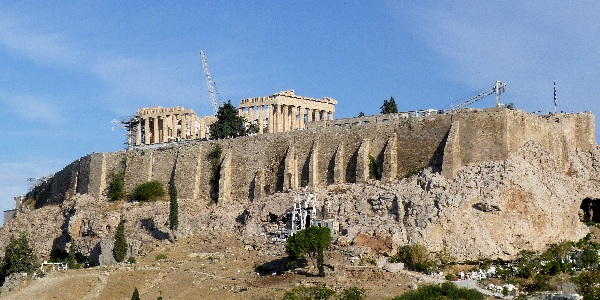 |
| The Parthenon is the best known of the structures from the Pericles era. It has clearly had its ups and downs. One of the biggest downs came in 1687 when Athens was under siege by the Venetians. The Parthenon was used to store gun powder, which seemed like a good idea until a Venetian cannonball hit the structure and everything blew up. Originally conceived as a temple to the goddess Athena, it has also served as a Christian church and a Muslim mosque. | 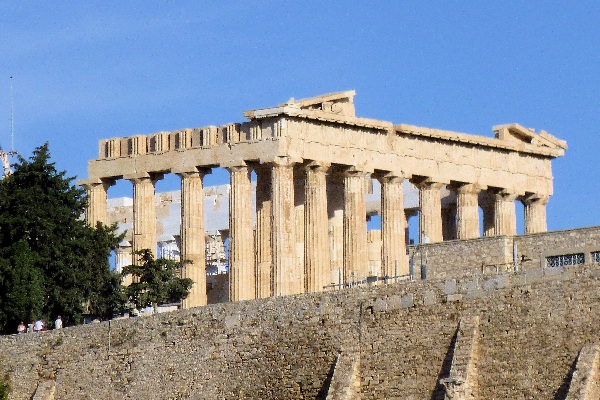 |
| The Parthenon is being aggressively restored. Craftsmen are reconstructing columns, and the cranes are almost as prominent as the building itself. | 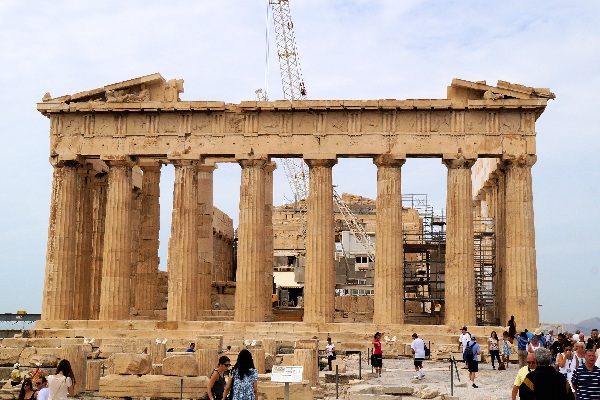 |
| The Erechtheion is one of the most intriguing structures on the Acropolis, largely for its "Porch of the Maidens," to those of us who are not students, but its history is fully as deep and complex as that of the Parthenon. | 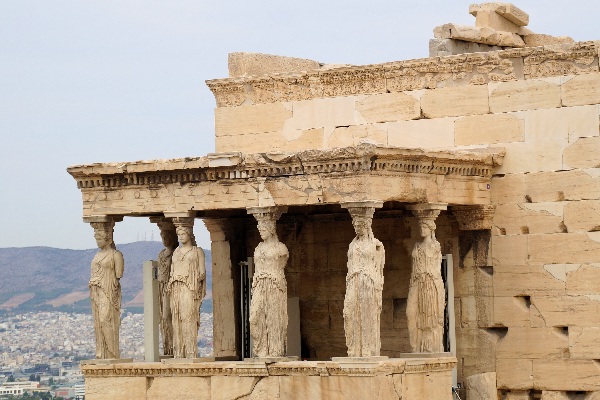 |
| The Acropolis Museum provides a great display of artifacts preserved from the citadel. This museum opened in 2009. The top floor is skewed to align with the Parthenon. The lowest level of this museum is an active archaeological site, and it is really obvious on the top level where the Elgin Marbles would be displayed if they were liberated from the British Museum. | 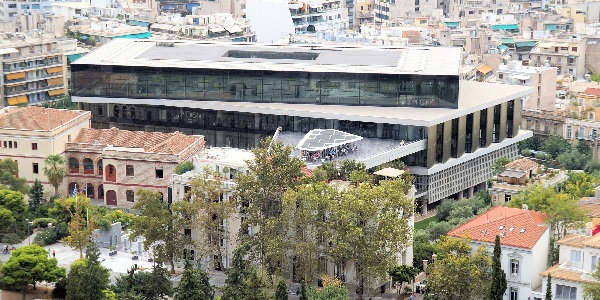 |
| Just northwest of the Acropolis, you find the Agora of Athens. It goes back to the sixth century BC, and it was rebuilt after the Persians were kicked out of Athens in 478 BC. Most of the Agora is pretty low in profile, but the Temple of Hephaestus stands out. | 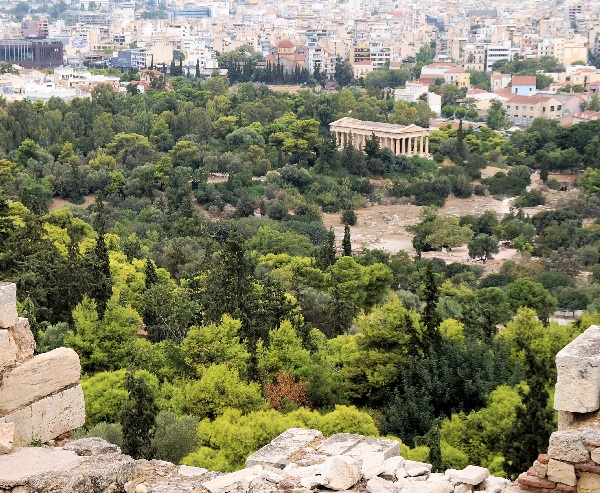 |
| The Agora was the center of public life in ancient Athens, and it had temples, wells, statues and theaters. | 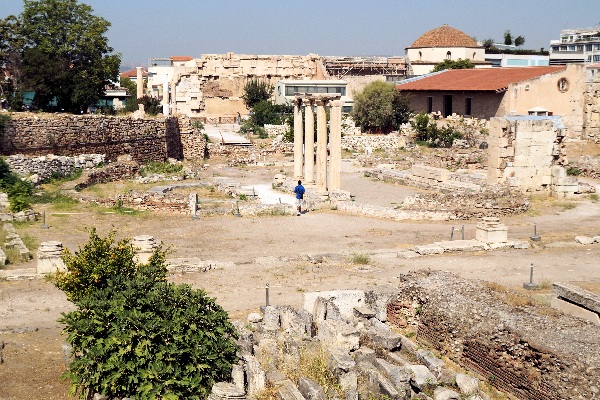 |
| The
Temple of Hephaestus was inaugurated in about 415 BC, after about 30
years of construction. The building escaped the ravages visited
on the Acropolis, and it remains close to its original condition.
From about 700 AD to 1834, it served as a Christian church,
dedicated to St. George. Hephaestus was the patron god of metal working and craftsmanship. | 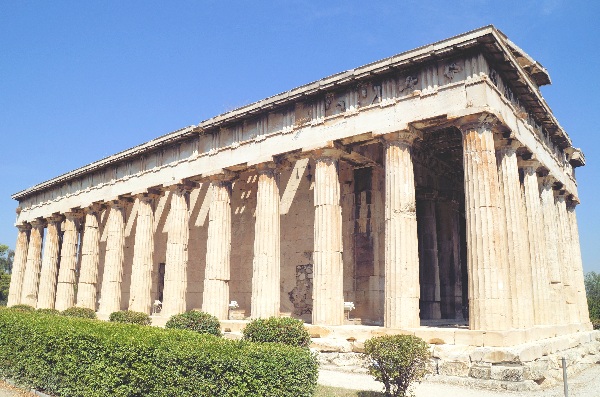 |
| Our first trip outside Athens was an overnight tour to Argolis, in the Pellopenese. The first stop was the Corinth Canal, then Mycenae, overnight in Nafplio, and back to Athens with a stop at Epidaurus. | 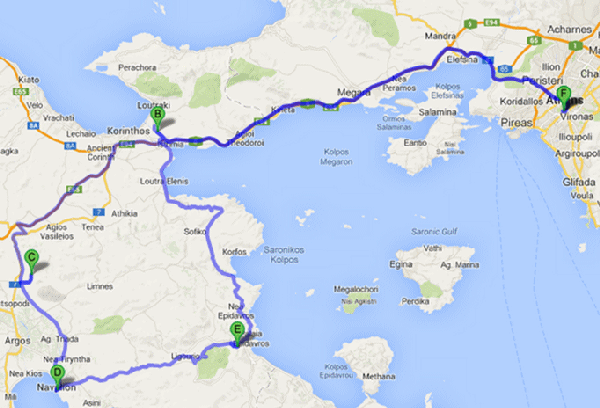 |
| From the seventh century BC, the Greeks have wanted a short cut between the Saronic Gulf and th Aegean Sea to the Gulf of Corinth. However, it took millenia to get the job done. The Corinth Canal was finally opened in 1893. It is a sea-level canal, only 4 miles long, but it turns the Peloponnesian peninsula into an island. The canal is only 70 feet wide, so its utility for modern ships is very limited. Still, it carries about 11,000 vessels a year. | 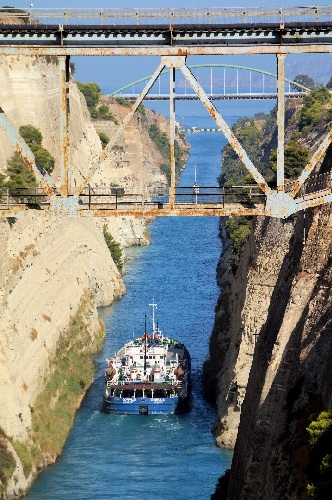 |
| The acropolis of Mycenae is famous for its Lion Gate, and it is a site that pre-dates Greek civilization. It was probably settled around 2000 BC, and it persisted as an important center for about 800 years. | 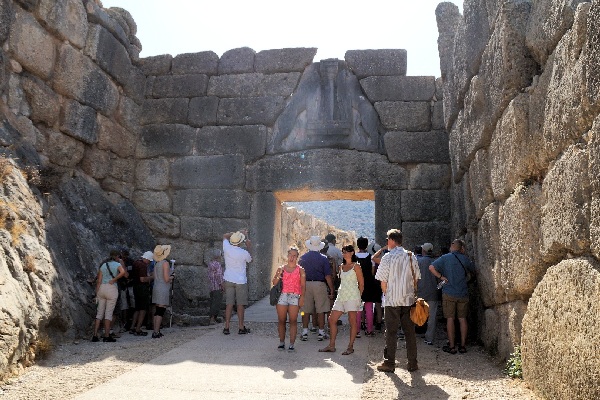 |
| This is the throne room of the Mycenaean kings, and Homer believed (400 years after the fact) that Agamemnon launched the Trojan War from this room. | 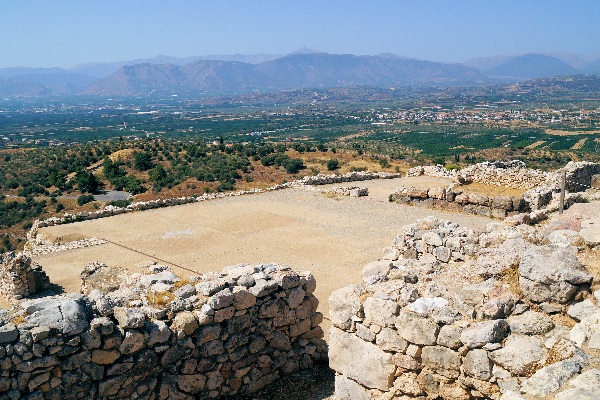 |
| The Treasury of Atreus is sometimes called the Tomb of Agamemnon, but it is probably neither. It is more likely a tomb for one of the earlier kings of Mycenae. | 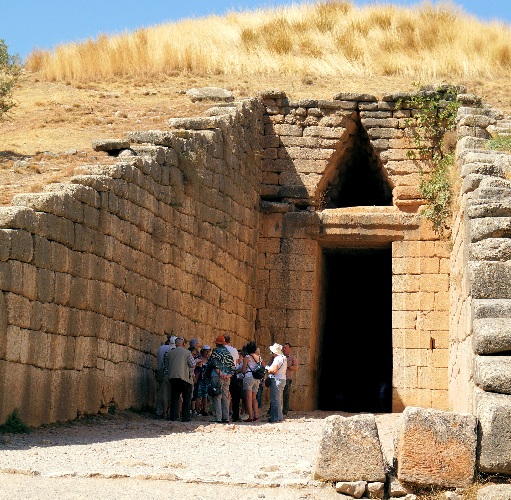 |
| Nafplio is a historic city on the Argolic Gulf. As a nice port city, it has been occupied by the Franks, the Byzantines, the Venetians and the Ottomans. Venice built a total of three fortresses here. In 1821, this was the seat of government for the First Hellenic Republic, in the process of being liberated from the Ottoman Empire. The capital moved to Athens in 1934. | 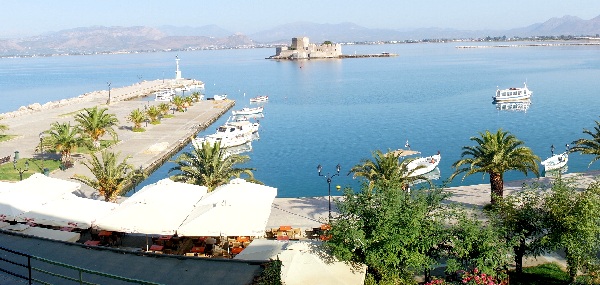 |
| Even though this fortress was built by the Venetians in 1471, it is still known by its Ottoman name, Bourtzi, meaning Tower. This fortress was taken from the Turks in 1822, and the Greeks used it to support a siege of Nafplio. The liberation of Nafplio from the Turks was the first step in creating a modern, independent Greece. | 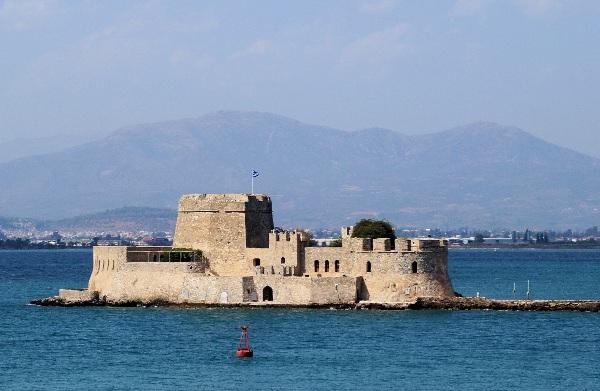 |
| In the heart of the compact town of Nafplio, we find another Syntagma Square. This honors the first constitution of the Hellenic Republic. Actually, it looks like it honors al fresco dining. | 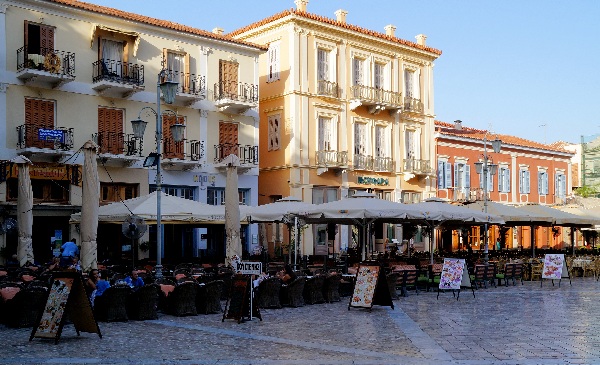 |
| The Palamidi Fortress really looks the part, standing 600 feet above the town of Nafplio. Built by the Venetians, it was captured by the Turks, and then finally captured by the soldiers intent on creating a new, independent Hellenic Republic in 1822. | 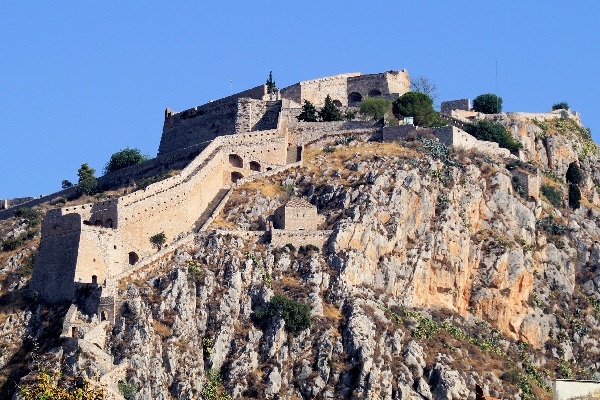 |
| The interior of the Palamidi Fortress is a maze of magazines, dungeons, steps and ramparts. There is even a chapel. Also, they say that there was a weak point, which help the Ottoman Turks take this fortress from the Venetians. Then the Turks forgot, so the Greeks could take this fortress from them, as part of their drive for independence in 1821. | 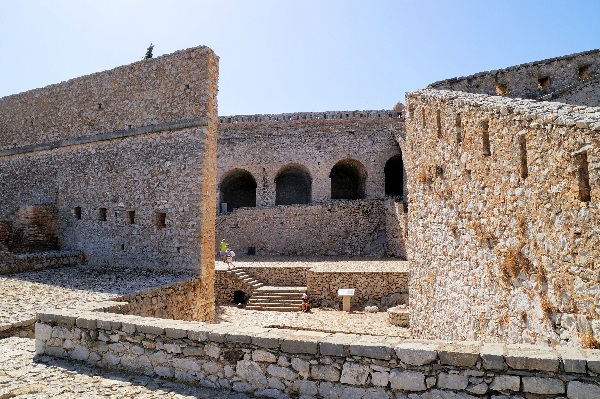 |
| Our return to Athens was via Epidaurus, where we stopped at Sanctuary of Asklepeios, a World Heritage theater. The first 34 rows date to the 4th century BC. The next 21 rows were built by the Romans. The house, noted for its fine acoustics, seats about 15,000 people, and it is still used for dramatic and musical performances. | 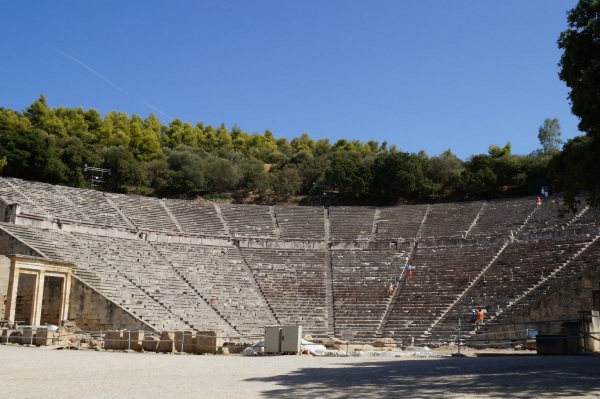 |
| We visited Delphi as a day trip from Athens, which was a lot of riding on a motor coach. | 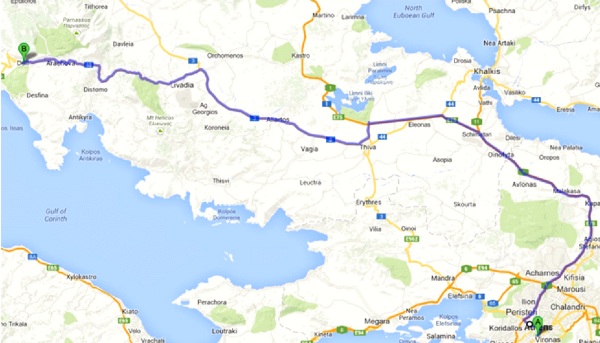 |
| Arachova, Greece is just a short distance away from Delphi. This town of 4,200 people is a tourist stop for skiers in the winter. It is high, but just to the north, Mount Parnassus is much higher. | 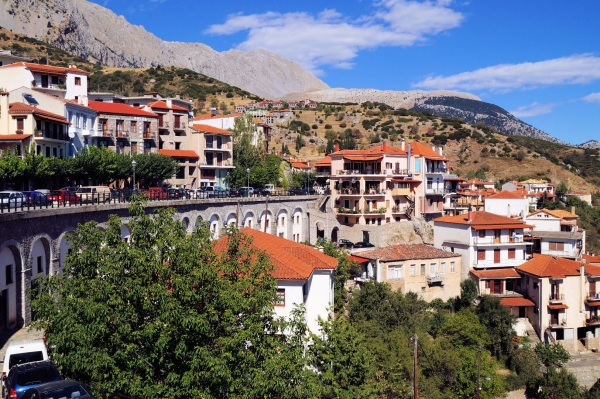 |
| The Sanctuary of Athena Pronaia is part of the Delphi archaeological site. This round temple was built around 360 BC, and it is about a half mile from the older, main site at Delphi. | 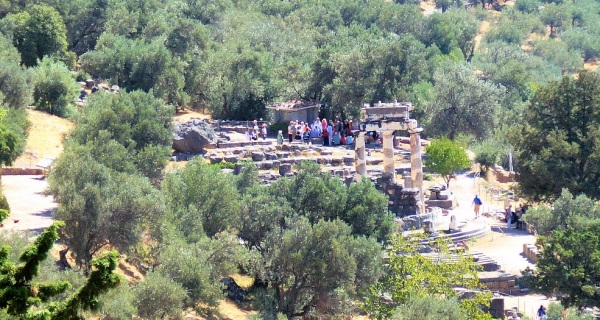 |
| The heart of the Delphi site is the Temple of Apollo. The various temples of Apollo are the homes of oracles, and of course the Delphic oracle Pythia is the most famous. | 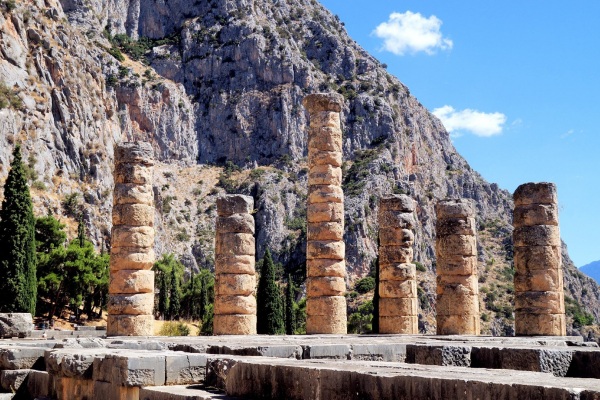 |
| One reaches the Temple of Apollo by taking the Sacred Way, and like any tourist route, it was a major commercial attraction. This is the Agora or Roman Market, just outside the entrance to the Sacred Precinct. | 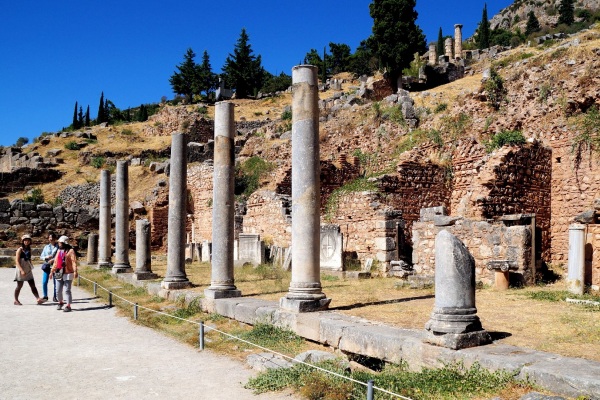 |
| The Treasury of Athens has a commanding location along the Sacred Way. It is believed that this celebrated Athens victory at Marathon, and it was built around 490 BC. What we see here was rebuilt around 1905. | 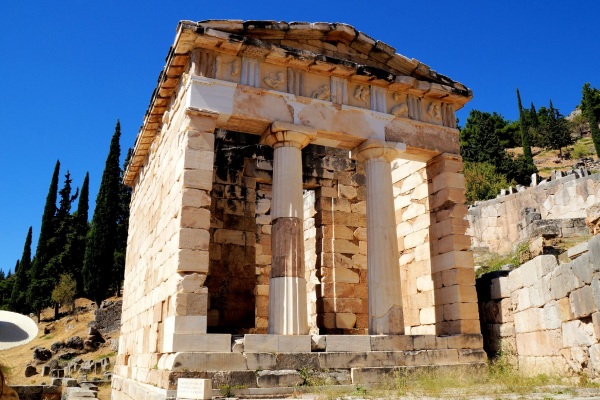 |
| Delphi is high above the Pleistos Valley, on the side of Mt. Parnassus. At the end of this valley is the Corinthian Sea. Delphi's elevation is about 1400 feet above the sea. | 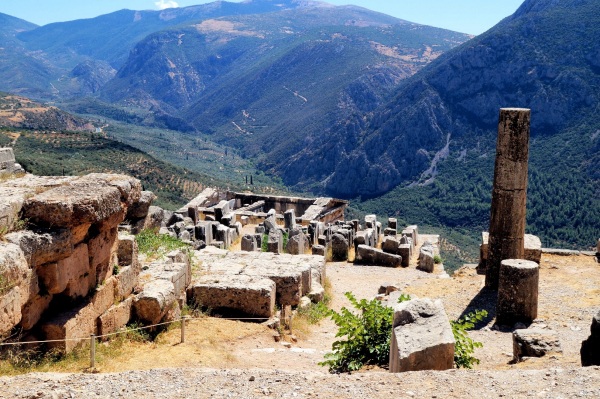 |
| Our last day trip out of Athens was a cruise on the Saronic Gulf.. We had three stops, Aegina, Poros and Hydra. | 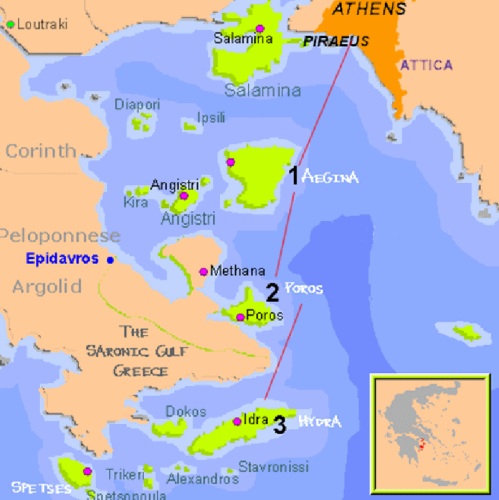 |
| The first stop was Aegina, and coming into the port, the Hill of Kolona is on the port side of the ship. This column is all that remains of a Temple to Apollo built around 520 BC. Most of the destruction came in the 4th century by Christians who found this temple idolatrous. | 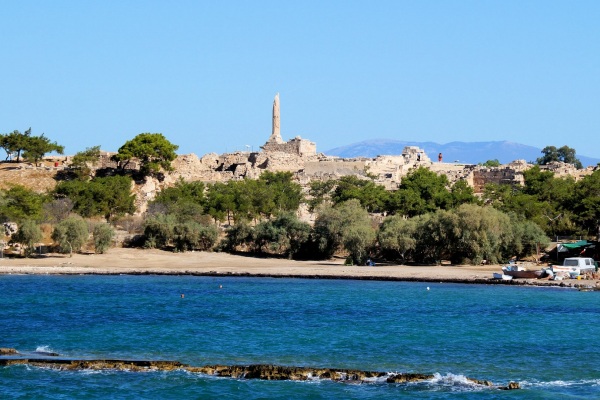 |
| In the heart of the town of Aegina we find this piece of modern architecture. The Tower of Markellos was built in 1802, and it served as the home of Greece's parliament before it moved to Nafplio in 1821. | 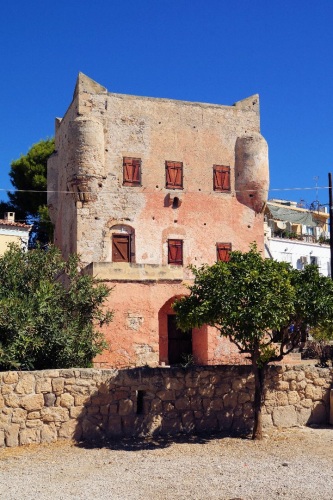 |
| As our boat came into dock at Poros, a very small Saronic island, the most significant landmark is the town's clock tower. It is hardly ancient; 1927 is pretty modern in these parts. The island is a charmer, but its population is less than 4,000. | 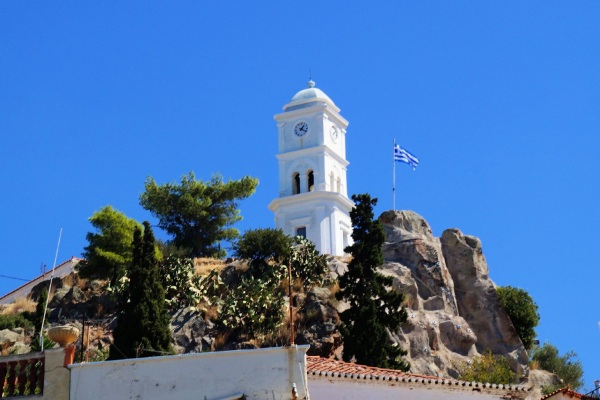 |
| As we left Poros, we passed the island on the west, where it is separated from the Peloponnese by about 200 yards. | 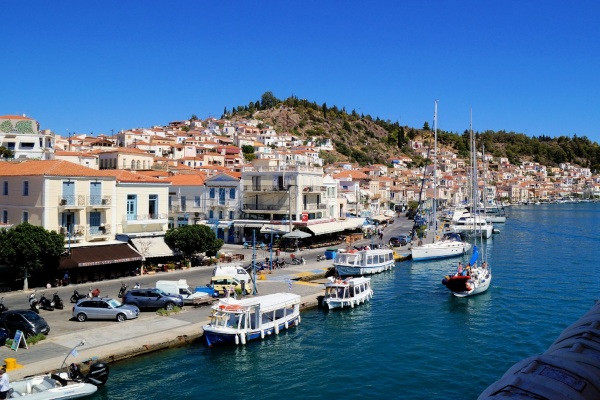 |
| Hydra is extremely popular as a destination for Athenians. It has hotels, restaurants and a town clustered around the harbor. The town extends up into the hills. The port town is less than 2000 people and there are villages with minute populations, a dozen or two. | 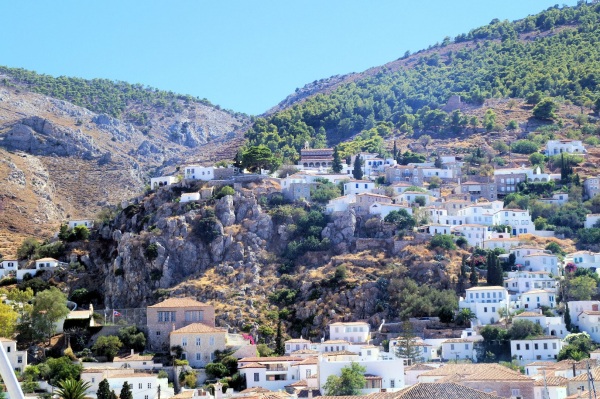 |
| What Hydra does not have is cars. If it is too far to walk, then you can hire a donkey. Of course, being one of the Saronic islands, boats abound. The big catamaran was our transport from and to Athens. | 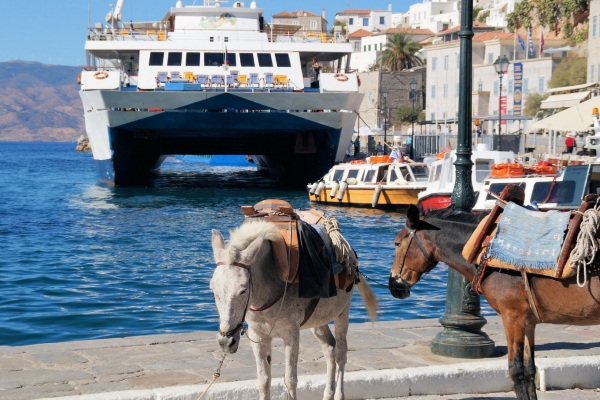 |
| Before we made our way back to the port of Pireaus, the sun set over the Saronic Gulf. The next morning would be our departure from Athens. | 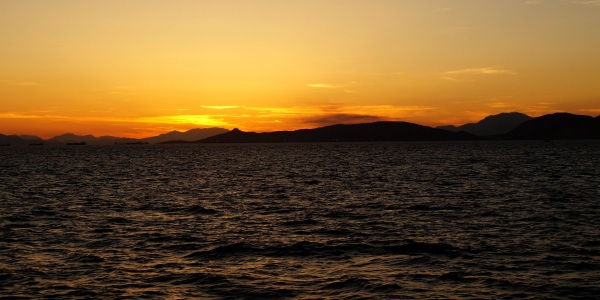 |